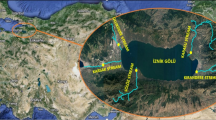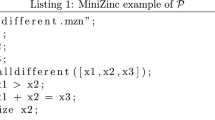Abstract
Reservoir sedimentation can represent a major threat to water supply and should be considered when establishing a reservoir's design life. This study optimized reservoir management using a Dynamic Programming Neural Network by incorporating an optimal operation rule devised to minimize the gap between water releases and water irrigation demands. The Foum El-Gherza Dam in Algeria was selected to validate the proposed optimization model. The optimized dredging model saved large quantities of water from April to October (dry summer season), economizing a total of 10.25 million m3 or 9% more water over a 4 year period. Dredging increased the satisfaction rate of water demand from 16% (historical releases) to 44% (optimized releases), while a satisfaction rate of 34.75% (optimized releases) was obtained in the case of no-dredging. The operation rule generated from the dredging operation proved to be more reliable, more resilient and less vulnerable to satisfy water demand patterns on a monthly basis. Finally, the dredging operation's optimal releases were superior to that obtained in the no-dredging operation case demonstrating that dredging is an effective solution to tackle reservoir sedimentation if it is incorporated as part of a holistic dam management strategy. However, optimized releases obtained during venting were inferior to those of the no-venting case due to the excess water releases required for venting. This study provides practical information on the extent of modelling applications for future perspectives on the need for advanced reservoir sedimentation management.









Similar content being viewed by others
References
Altunkaynak A (2009) Sediment load prediction by genetic algorithms. Adv Eng Softw 40(9):928–934
Annandale GW, Morris GL, Karki P (2013) Extending the life of reservoirs: sustainable sediment management for dams and run-of-river hydropower. The World Bank, Washington, DC
Basson GR, Rooseboom A (1999) Dealing with reservoir sedimentation—dredging. Water Research Commission Report No TT 110/99, South Africa
Basson GR, Rooseboom A (2008) Mathematical modelling of sediment transport and deposition in reservoirs. Bulletin, ICOLD
Benfetta HNE, Ouadja A (2017) Leakage, evaporation and sedimentation affecting the storage in arid area: case studies of the Foum El-Gherza and Gargar Dams, Algeria. J Agric Biol Sci 12(10):369–382
Benfetta H, Ouadja A, Hocini N (2017) Enhancement of the study of water leaks in the Algerian dam of Foum El Gherza. Arab J Geosci 10:482
Cancelliere A, Giuliano G, Ancarani A, Rossi G (2002) A neural networks approach for deriving irrigation reservoir operating rules. Water Resour Manag 16(1):71–88
Chamoun S, De Cesare G, Schleiss AJ (2016) Managing reservoir sedimentation by venting turbidity currents: a review. Int J Sedim Res 31(3):195–204
Chandramouli V, Raman H (2001) Multireservoir modeling with dynamic programming and neural networks. J Water Resour Plan Manag 127(2):89–98
Chang FJ, Lai JS, Kao LS (2003) Optimization of operation rule curves and flushing schedule in a reservoir. Hydrol Process 17(8):1623–1640
Chen F, Zhang F, Fang N, Shi Z (2016) Sediment source analysis using the fingerprinting method in a small catchment of the Loess Plateau, China. J Soils Sedim 16(5):1655–1669
Chen SC, Wang SC, Wu CH (2010) Sediment removal efficiency of siphon dredging with wedge-type suction head and float tank. Int J Sedim Res 25(2):149–160
Fayaed SS, El-Shafie A, Jaafar O (2013) Reservoir-system simulation and optimization techniques. Stoch Env Res Risk Assess 27(7):1751–1772
Hajiabadi R, Zarghami M (2014) Multi-objective reservoir operation with sediment flushing; case study of Sefidrud reservoir. Water Resour Manag 28(15):5357–5376
Kantoush S, Sumi T (2013) Reservoir sedimentation and sediment management techniques in the Nile River basin countries. Paper presented at the 12th International Symposium on River Sedimentation, Kyoto
Khan NM, Tingsanchali T (2009) Optimization and simulation of reservoir operation with sediment evacuation: a case study of the Tarbela Dam, Pakistan. Hydrol Process Int J 23(5):730–747
Labadie JW (2004) Optimal operation of multireservoir systems: state-of-the-art review. J Water Resour Plan Manag 130(2):93–111
Lopez SJL (1978) Mathematical modeling of sediment deposition in reservoirs. Hydrology papers (Colorado State University); no. 95
Morris GL (2020) Classification of management alternatives to combat reservoir sedimentation. Water 12(3):861
Palmieri A, Shah F, Dinar A (2001) Economics of reservoir sedimentation and sustainable management of dams. J Environ Manag 61(2):149–163
Petkovsek G, Roca M (2014) Impact of reservoir operation on sediment deposition. Paper presented at the Proceedings of the Institution of Civil Engineers-Water Management
Randle T, Morris G, Whelan M, Baker B, Annandale G, Hotchkiss R, Boyd P, Minear J T, Ekren S, Collins K, Altinakar M, Fripp J, Jonas M, Kimbrel S, Kondolf M, Raitt D, Weirich F, Eidson D, Shelley J, Vermeeren R, Wegner D, Nelson P, Jensen K, Tullow D (2019) Reservoir sediment management: building a legacy of sustainable water storage reservoirs. National Reservoir Sedimentation and Sustainability Team White Paper
Rashid MU, Shakir AS, Khan NM, Latif A, Qureshi MM (2015) Optimization of multiple reservoirs operation with consideration to sediment evacuation. Water Resour Manag 29(7):2429–2450
Remini B (2017) Une nouvelle approche de gestion de l’envasement des barrages. Larhyss Journal 31:51–81
Remini B, Bensafia D, Missoum M (2015) Silting of Foum El-Gherza Reservoir. GeoScience Eng 61(1):1–9
Schleiss AJ, Franca MJ, Juez C, De Cesare G (2016) Reservoir sedimentation. J Hydraul Res 54(6):595–614
Shahidi A (2009) Evaluation of combined model of DP and Neural Networks in single reservoir operation. J Appl Sci Res 5(10):1307–1312
Shaikh SA (2015) Optimal operation of single reservoir using artificial neural network. Int J Civ Eng Technol 6(6):124–132
Sharifi F, Haddad OB, Naderi M, Alimohammadi S (2005) Continuous decision making in optimal reservoir operation using DP-ANN. Paper presented at the Proceedings of the 6th WSEAS international conference on Evolutionary computing
Shokri A, Haddad OB, Mariño MA (2013) Reservoir operation for simultaneously meeting water demand and sediment flushing: Stochastic dynamic programming approach with two uncertainties. J Water Resour Plan Manag 139(3):277–289
Sumi T (2008). Evalutation of efficiency of reservoir sediment flushing in Kurobe River. Paper presented at the Proceedings 4th International Conference on Scour and Erosion (ICSE-4). November 5–7, 2008, Tokyo, Japan
Tebbi F, Dridi H, Morris G (2012) Optimization of cumulative trapped sediment curve for an arid zone reservoir: Foum El-Gherza (Biskra, Algeria). Hydrol Sci J 57(7):1368–1377
Tigrek S, Aras T (2012) Reservoir sediment management. CRC Press, Taylor & Francis Group 13:978-1-4665-1271-9
Vaghefi S, Mousavi S, Abbaspour K, Ehtiat M (2012) Reservoir operation optimization using imperialist competitive algorithm to balance sediment removal and water supply objectives. J Iran Dam Hydropower Power 1(2):1–16
Vedula S, Mujumdar P (2005) Water resources systems: modeling techniques and analysis. Tata McGraw-Hill, New York
WCD (2000) Dams and development: a new framework for decision-making: The report of the world commission on dams. Earthscan, London
White R (2001) Evacuation of sediments from reservoirs. Thomas Telford Publishing, London
Wulandari DA, Legono D, Darsono S (2014) Reservoir Operation to Minimize Sedimentation. Int J Sci Eng 6(1):16–23
Wurbs RA (1991) Optimization of multiple-purpose reservoir system operations: a review of modeling and analysis approaches. Hydrologic Engineering Center, US Army Corps of Engineers
Yadav A, Chatterjee S, Equeenuddin SM (2018) Suspended sediment yield estimation using genetic algorithm-based artificial intelligence models: case study of Mahanadi River, India. Hydrol Sci J 63(8):1162–1182
Yin XA, Yang ZF, Petts GE, Kondolf GM (2014) A reservoir operating method for riverine ecosystem protection, reservoir sedimentation control and water supply. J Hydrol 512:379–387
Zhang F, Wai OW, Jiang Y (2010) Prediction of sediment transportation in deep bay (Hong Kong) using genetic algorithm. J Hydrodyn 22(5):599–604
Acknowledgements
National Agency of Dams (NAD) in Algeria deserve special acknowledgement from the authors for providing space, facilities, technical support, and administrative support.
Author information
Authors and Affiliations
Corresponding author
Ethics declarations
Conflict of interest
The author declares no conflict of interest.
Additional information
Editorial Responsibility: Samareh Mirkia.
Rights and permissions
About this article
Cite this article
Boudjerda, M., Touaibia, B., Mihoubi, M.K. et al. Application of sediment management strategies to improve reservoir operation: a case study Foum El-Gherza Dam in Algeria. Int. J. Environ. Sci. Technol. 19, 10957–10972 (2022). https://doi.org/10.1007/s13762-021-03896-w
Received:
Revised:
Accepted:
Published:
Issue Date:
DOI: https://doi.org/10.1007/s13762-021-03896-w




